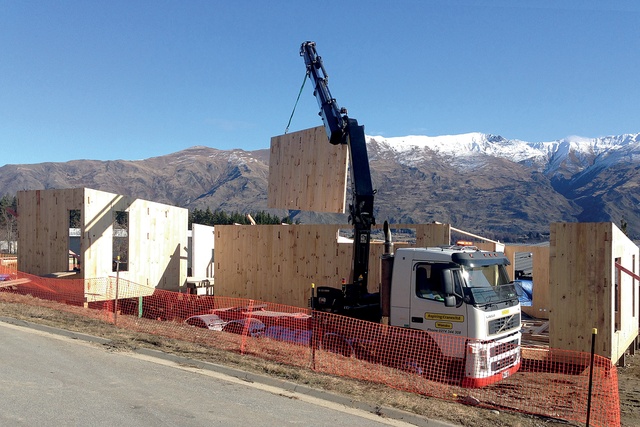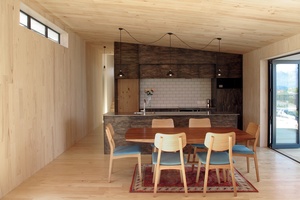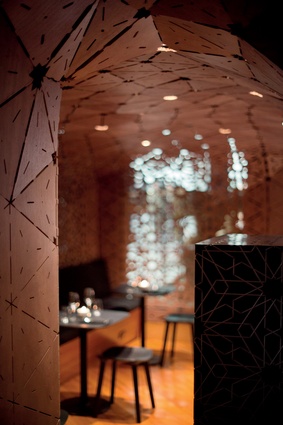Darth Vader and the Death Star
Technology is developing at an unprecedented pace – inevitably influencing the way architecture is designed and constructed. Guy Marriage, a senior lecturer at Victoria University of Wellington’s School of Architecture, investigates.
Have you ever wondered how Darth Vader built the Death Star? Ever since that tune blared out in cinemas back in the ’70s and that script rolled out those magic words “a long long time ago in a galaxy far far away…”, the logistics of spatial construction have obsessed me. Exactly how do evil overlords manage to build megastructures in outer space, when we seem to spend zillions just to hoist one small satellite into orbit? Where did all the steel come from to build the Death Star and the Empire’s vast war fleet, and how did they get it all floating up there out of the reach of gravity? The simple answer: Hollywood. Another answer: evolving technology.
Technology is currently evolving at a staggering speed in many industries, due to the progress of digital technology and the interwebs. We architects work in a highly practical world but do you ever have the feeling that life would be easier if you designed buildings for Weta, where gravity and reality have no boundaries, and buildings never leak? After all, you never hear anyone on Pandora complain that their rubber roofing membrane is deteriorating.
The schools of architecture in New Zealand need to be – and mostly are – positioned at the laser-cutting edge of progress within the construction industry. Students may not be taught much about delicate shading with pencil and paper these days but their knowledge of 3D programs should be second to none; at Victoria, 3D printers have moved out of the workshops and now sit beside students at their desks.

Laser-cutting in student projects is now old hat. A focused stream of energy cutting through material with pinpoint accuracy, laser-cutting allows simple two-dimensional cutting of a surface – perfect for pattern-making. Cool young people use it for enlivening flat sheet materials into elaborate fretwork of replicating patterns, the practicalities only as limited as your imagination: Cheshire Architects has used it for the walls of Milse, an Auckland restaurant; Studio Pacific Architecture has used it to penetrate balustrades on a Council housing project in Wellington; Michael Arad’s memorial to September 11 at the World Trade Center in New York has every one of the names of the 2,977 dead laser-cut (or plasma-cut) right through quarter-inch solid steel. Even graffiti artists laser-cut their stencils for their latest throw-ups; it’s sharp, it’s replicable and it’s reproducible on a grand scale.
Computer numerically controlled (CNC) technology is a silly name really – in this day and age, what is there that isn’t computer controlled? Your car, your phone and even your fridge are all computer controlled. Thomas Denhardt will take you through some CNC projects as examples [in a future ArchitectureNow article], but the real focus here is that it uses a super-sharp and super-accurate drill bit to cut out shapes in three dimensions, controlled by a highly accurate drill. Our students use it for replicating site models and creating 3D forms. Whether these are cut from foam or from a piece of solid kauri log makes no difference to the machine – it merely needs to cut at different speeds.
At Victoria, we have a three-axis router, which can cut out a landscape as big as a sheet of plywood (and much thicker). The real slicing, cutting edge though, is with groups like XLam, which has a five-axis router, and Makers of Architecture, which has a full-scale in-house CNC machine just to build its own houses. Are we seeing the return of the architect as master-craftsman? It’s simple: design, fabricate, assemble.
But these are both reductive technologies that work on cutting away – deleting material and leaving you with the leftovers. Surely, for architects, the thing we want to explore is the use of additive technologies – like 3D printing. The concept is refreshingly simple; just like an old inkjet printer, the head of a 3D printer can extrude thin layers of material, which are slowly but surely built up into objects.

This technology is taking off in so many fields at present, with the medical field printing new parts for the human body, custom shaped for individual people; hip joints, a prosthetic nose and ear, and even a new trachea have been made at our School of Design. In the design world, real-life products are being printed daily but, in the architectural world, we’ve been using mostly 3D-print technology for making models of projects – allowing multiple variations on designs to be refined in miniature, using a hard thermoplastic. It’s a bit slow and laborious to build up layer by layer but the beauty of the system is that, if you want to, every time you print you can create a one-off: mass customisation!
Firms like Hopkins Architects and Grimshaw have long been advocates of using castings to solve detail junctions, often with incredibly beautiful results. Castings, however, are highly expensive to manufacture and so costs come down only as numerous identical copies are produced. But 3D printing of those bracket junctions may allow almost infinite variations, with no two parts the same. Already, Fletcher Aluminium Windows is 3D printing components for its latest no-flashing window system.
Once the idea is out there, it runs free. Want to print in something other than plastic? Change the material; you can now ‘print’ metal (more accurately, sintered powder is fused together, creating a metal solid). Want to change the scale at which it prints out? Scale up the machinery, make a head capable of printing out a plasticcy concrete and print out a house. This is the holy grail: 3D printing whole houses, with groups in China, UK and USA all undertaking projects over the last year. Yingchuana New Materials is leading the charge.
However, videos of Chinese robotic printing of entire houses by laying down fat rolls of gooey concrete show some pretty low-quality finishes at present (improving rapidly), and questionable constructional techniques (improving slowly). If you don’t trust a system of fibre-cement sheeting not to leak, why do you think a system of fibre-cement gloop would work any better? How would you reinforce the wall against seismic forces and how do you seal in flashings to stop them leaking? Where is the vapour barrier? How do the costs stack up to ‘print’ a house in situ, as opposed to printing it in a factory and taking segments to the site?

The demonstration of the 3D-printed house was a little economical with the truth when it showed the finished product: I’m fairly certain it didn’t print out the windows in situ, complete with glazing and rubber gaskets in the window frames, although, in time, perhaps, it can. Still, 10 small houses in one day! Wow!
It is obviously early days yet but I doubt that 3D printing of entire houses is going to be the future on this planet. Personally, I think that there is more scope for using 3D-print technology to custom manufacture parts, rather than whole buildings, but the real goal of 3D printing in the immediate future lies on another celestial body. I still don’t have a solution to building the Death Star but we do have potential solutions to building structures on other planets.
Instead of hauling a few thousand sheets of plywood up to the moon to create Moonbase Alpha, serious efforts are being made to plan out how to 3D print a lunar HQ, using moon dust (or regolith) as the base material. And why not? There is a huge depth of cosmic dust just waiting to be scooped up and put into the material chute of a robotic 3D printer. The robot can literally suck up the dust, mix it with the right amount of starlight and print out the walls of a new lunar station with zero human interaction. Inevitably, Foster + Partners is already onto it, designing Lunar HQ number 1 as a trial for similar construction on Mars.
Back on this planet, one of the more exciting demonstrations is a 3D printer let loose in the Sahara Desert: the Solar Sinter project by Markus Kayser. Completely solarpowered of course, the printer took in raw material (a rather plentiful supply of sand) and melted the silica to create glass structures. Kayser created a 3D framework straight out of the raw sand dunes: a way of building, perhaps, where before there was nothing.
My immediate thought was that it would be fantastic to have a fleet of these solar-powered printing droids working away in the desert, creating building structures just out of sun and raw silica. If we program them right, we can come back in a couple of centuries and find a castle built of sand. Some, of course, would argue that architects have already been doing just that for the last several centuries.













